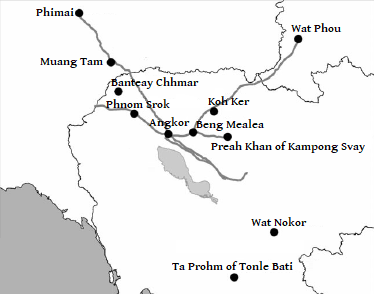Development: "houses of fire" on the road network of Jayavarman VII
The Preah Khan stele dated to 1191 CE (see Cœdès 1941) and the decorative use of the Lokesvara motif. The stele describes a series of 121 vahni-griha found along three roads and in specific Angkorian temple enclosures. [4] The decorative use of the Lokesvara motif, which represents the Buddha of compassion, is associated with the switch to Buddhism as state religion for Jayavarman VII and his successor Indravarman II (1220-1270 CE).
In the late 13th century, one hundred years after the reign of Jayavarman VII, Zhou Dagan mentioned the presence of samnak, or rest stops, which he compared to the post houses more common in China. [5]
Though the massive houses of fire fell into disrepair with the collapse of the Khmer Empire, the use of specific sala for travelers remained: in the 19th century, Henri Mouhot commented on the frequency of royal stations spaced approximately 20 kilometers apart for the king on the route between Kampot and Udong.
Archeology: rediscovering the religious purpose of the houses of fire
In 1903, French archeologist A. Foucher recognised that these structures served first and foremost religious purposes and were not simply ‘resthouses’, pointing out that stone is a material intended for the gods and not for human habitation. [6]
The first and only publication specifically addressing the ruins on the model of Prasat Teap Chei was conducted by Finot (1925) who provided descriptions of the size, decoration, orientation, and spacing of the dharmaçalas, a term that suggests both a religious and secular role.
Claude Jacques recently supported the use of theses structures as fire shrine as it more accurately represents the inscription and possibly points to its role in housing a ‘sacred fire’, images of which are depicted being carried in processions on the walls of Angkor Wat, Banteay Chhmar and the Bayon. [7]
To this day, many Angkorian sites have been identified as houses of fire, in places such as Prohm Kel, Prasat Phtu, Teap Chei, Preah Khan, Ta Prohm, Kuk Top Thom and Prasat Kuk.


